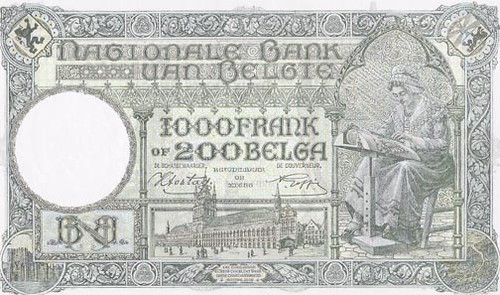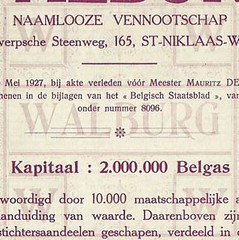
PREV ARTICLE
NEXT ARTICLE
FULL ISSUE
PREV FULL ISSUE
BELGIUM'S BELGA CURRENCY
With all of the recent headlines surrounding the Euro and the possibility of Greece and other countries leaving the Euro zone, this article from CoinsWeekly is timely. It discusses the Belga, a currency created by Belgium when it left behind the Belgian Franc in a time of monetary trouble. Here's an excerpt from the article by Franky Leeuwerck. Be sure to read the complete version online.
-Editor
At first sight it looked like a rather plain certificate. But I was puzzled because it was not mentioning the familiar Belgian Franc as its currency denomination but Belgas. Thundering typhoons, what were Belgas?
A strong Belgian Franc for King Leopold II
Reichsmarks induce Belgium inflation The following years saw a continuous fall of the value of the Franc in comparison to the Pound Sterling and the US Dollar, causing further flight of Belgian capital. Eventually, the government Poullet-Vandervelde was forced to resign. Strong measures were needed to stabilize the Belgian currency and to put the evolution of the Belgian national debt back on the right track.
Belgium leaves the Latin Monetary Union and introduces the Belga
Belga coexists with Belgian Franc

1927 saw appearing the first notes mentioning both currencies and 3 year laters ‘Belga-Franc’ coins appeared on the market. Nevertheless, the plan was a success and did stabilize the Belgian currency. The Belga was not popular when it was used and it was soon forgotten after it disappeared from the market. In the past decades the Belga was seldom mentioned in history lessons at schools, so nowadays few people know about its past existence. And that explains the mystery of the Belga, people simply forgot about the Belga except for collectors of coins and notes.
To read the complete article, see:
Twenty years of Belgas
(www.coinsweekly.com/en/Twenty-years-of-Belgas/8?&id=210&type=a)
The Numismatic Bibliomania Society is a non-profit organization promoting numismatic literature. See our web site at coinbooks.org. To submit items for publication in The E-Sylum, write to the Editor at this address: whomren@gmail.com To subscribe go to: https://my.binhost.com/lists/listinfo/esylum All Rights Reserved. NBS Home Page Contact the NBS webmaster 
|
